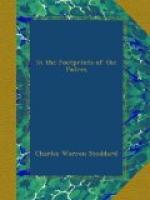I can testify that the town knew little or no change in the two years that followed. The “El Dorado” on the plaza, and the “Arcade” and “Polka” on Commercial Street, were still in full blast. How came I aware of that fact? I was a child; my guide, philosopher and friend was a child, and we were both as innocent as children should be. It is written, “Children and fools speak the truth.” I may add, “Children and ‘fools rush in where angels fear to tread.’” The doors of “El Dorado,” of the “Arcade,” and the “Polka” were ever open to the public. We saw from the sidewalk gaily-decorated interiors; we heard enchanting music, and there seemed to be a vast deal of jollity within. No one tried to prevent our entering; we merely followed the others; and, indeed, it was all a mystery to us. Cards were being dealt at the faro tables, and dealt by beautiful women in bewildering attire. They also turned the wheels of fortune or misfortune, and threw dice, and were skilled in all the arts that beguile and betray the innocent. The town was filled with such resorts; some were devoted to the patronage of the more exclusive set; many were traps into which the miner from the mountain gulches fell and where he soon lost his bag of “dust,”—his whole fortune, for which he had been so long and so wearily toiling. There he was shoulder to shoulder with the greaser and the lascar, the “shoulder-striker” and the hoodlum; and they were all busy with monte, faro, rondo, and rouge-et-noir.
There was no limit to the gambling in those days. There was no question of age or color or sex: opportunity lay in wait for inclination at the street corners and in the highways and the byways. The wonder is that there were not more victims driven to madness or suicide.
The pictures were not all so gloomy. Six times San Francisco was devastated by fire, and all within two years—or, to speak accurately, within eighteen months. Many millions were lost; many enterprising and successful citizens were in a few hours rendered penniless. Some were again and again “burned out”; but they seemed to spring like the famed bird, who shall for once be nameless, from their own ashes.
It became evident that an efficient fire department was an immediate and imperative necessity. The best men of the city—men prominent in every trade, calling and profession—volunteered their services, and headed a subscription list that swelled at once into the thousands. Perhaps there never was a finer volunteer fire department than that which was for many years the pride and glory of San Francisco. On the Fourth of July it was the star feature of the procession; and it paraded most of the streets that were level enough for wheels to run on—and when the mud was navigable, for they turned out even in the rainy season on days of civic festivity. Their engines and hose carts and hook and ladder trucks were so lavishly ornamented with flowers, banners, streamers, and even pet eagles, dogs, and other mascots, that they might without hesitation have engaged in any floral battle on any Riviera and been sure of victory.




